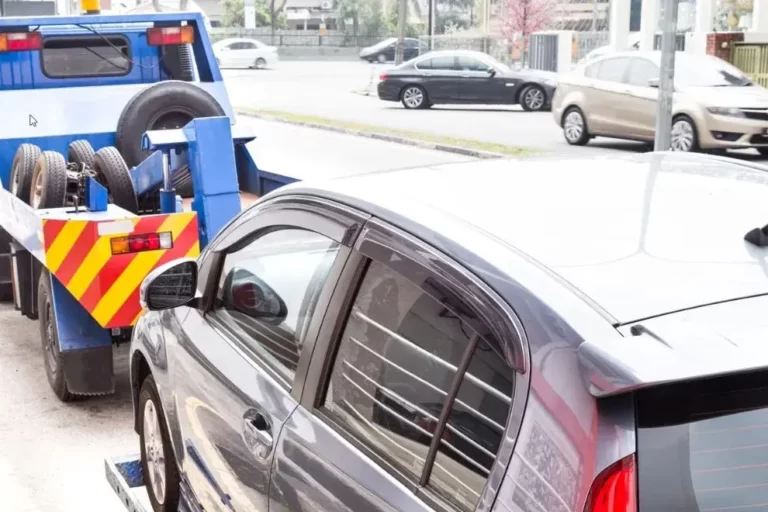How To Maintain Your Car’s Brakes For Safe Driving In Australia
Automotive safety should always be given importance when driving in Australia. Ensuring proper brake maintenance is vital for a secure driving experience, regardless of weather conditions and other factors. This article will cover how to optimally maintain your car’s brakes for maximum safety on Australian roads.
The Australian Motor Accident Commission (AMAC) emphasises the importance of regular maintenance and inspections of your vehicle’s braking system for automotive safety.
However, it can be challenging for drivers to understand what needs attention to keep their brakes functioning correctly. We will discuss the necessary steps and factors to consider when maintaining your car’s brakes, enabling safe driving throughout Australia.
Facts From The Australian Motor Accident Commission
Some facts from the Australian Motor Accident Commission about road accidents due to brake failure in Australia are:
- Brake failure, though rare, can lead to severe injuries or fatalities in road crashes.
- In 2020, the Bureau of Infrastructure and Transport Research Economics reported 1,106 road deaths in Australia, with three attributed to brake failure.
- Various factors can cause brake failure, including poor maintenance, faulty components, overheating, and external damage.
- Regularly checking and servicing brakes, following the manufacturer’s recommendations, avoiding overloading or overheating vehicles, and cautious driving in wet or slippery conditions can reduce brake failure risk.
- In case of brake failure, drivers should slow down using the handbrake, shift to a lower gear, steer to a safe area, and warn other road users with their horns or hazard lights.
Understanding Your Brakes
A vehicle’s brakes are crucial safety components, and maintaining them is essential for safe driving in Australia. Regularly testing your brakes ensures their proper functionality. This includes checking for wear or damage signs and assessing their performance during regular brake tests.
To test your brakes effectively:
- Inspect the brake pads for visible wear signs.
- Along with this visual inspection, take the car for a test drive to assess brake performance under different conditions, such as hills or curves.
- During this process, listen for any noises from the braking system and be vigilant for potential issues that could develop over time.
By taking these preventive measures, you can have peace of mind knowing that your brakes will work effectively when needed, ensuring your safety while driving in Australia. Regular testing and maintenance of your brakes are vital to keeping yourself and others safe.
Checking Brake Fluid Levels
When checking brake fluid levels, examine the fluid’s colour. It should be transparent, light brown, or golden. Any darker colour indicates contamination. Also, ensure the fluid level is between the minimum and maximum marks on the reservoir. If the level is below the minimum mark, replenish it to prevent issues with the braking system.
Checking Brake Fluid Color
Regularly checking brake fluid levels is critical to maintaining a car’s brakes. Locate and inspect the brake master cylinder, which should have a clear window indicating the brake fluid level in the reservoir.
Check the colour and clarity of the fluid during this inspection. Typically light amber or yellowish when new, the fluid will darken over time due to moisture contamination. Periodically testing its performance is recommended to prevent potential braking issues.
If signs indicate that parts may need replacing, such as discolouration from contaminants or an unusual odour, address these immediately to maintain safe driving conditions. Additionally, suppose bubbles appear around the glass measuring tube’s edge after removing it from the master cylinder. In that case, air pockets within the system must be removed before further use.
To ensure optimal safety on Australian roads, perform regular checks on all brake-related components, including checking brake fluid levels and testing their performance. If replacement parts are needed, pay attention to them to ensure proper functioning.
Checking Brake Fluid Level
Assessing the brake fluid level should include a visual inspection, wear assessment, and leak avoidance. First, locate and inspect the brake master cylinder, typically on the top or side of a car’s engine bay. The clear window in this area will indicate the fluid level. Note that the colour and clarity of the fluid can darken over time due to moisture contamination, necessitating periodic performance testing if any changes are observed.
Additionally, if bubbles appear around the glass measuring tube’s edge after removal, there could be air pockets in the system that must be removed immediately. Lastly, checking for wear signs or leakage can help prevent potential braking issues when traveling on Australian roads.
Examining The Brake Pads
After assessing brake fluid levels, it is crucial to inspect the brake pads. Evaluate wear and tear by looking at each pad individually. It may indicate a need for replacement if they appear worn or unevenly distributed. Brake pads are essential for vehicle safety and should be noticed during maintenance checks.
When assessing wear, consider the material thickness and any signs of cracking or splitting on the surface. It is also essential to check for dust near the brakes, which could indicate metal particles coming off of them. This may imply that parts in the braking system need replacement soon to maintain car safety while driving in Australia.
Regular maintenance checks and inspecting all necessary components help ensure reliable and effective brakes over time. Test for wear and replace parts as needed to maintain proper functioning. This enhances security on Australian roads, ensuring your safety while driving.
Inspecting The Rotors And Drums
Regular brake inspections are vital to safe driving in Australia. First, inspect rotors and drums to identify any signs of wear or damage. This includes examining cracks, warps, grooves, scoring marks, rust, heat discolouration, and other irregularities on both sides of the rotor/drum. Also, evaluate each component’s performance by engaging its brake system at low speeds over various distances (i.e., applying pressure to the brakes).
To ensure your vehicle’s brake system functions correctly, perform these tests regularly:
- Measure the thickness of the rotor/drums with a micrometre
- Inspect components such as callipers and wheel cylinders for leaks
- Confirm even distribution of friction material across the rotor/drum surface
- Verify pads/shoes have sufficient friction material remaining
- Assess each component’s performance by engaging its brake system at low speeds over different distances
Lastly, when inspecting rotors and drums, always use safety measures, including wearing protective gloves and eyewear while examining your braking system. Remember to note any changes to address them promptly before embarking on your next journey.
Adjusting The Brake Pedal
After inspecting your car’s rotors and drums, it is vital to adjust the brake pedal. The brake pedal should be adjusted to ensure the brakes work correctly.
Testing tolerances in the brakes can help you identify potential problems before they become serious safety issues. The following table shows key points for testing wheel-brake systems:
| Step | Description | Tools Required |
| 1 | Check Brake Pedal Free Play | Measuring Tape or Ruler |
| 2 | Test Brake Pressure | Pressure Gauge |
| 3 | Inspect Caliper Sliding Mechanism | Wrench Set |
| 4 | Measure the Drum Inside Diameter | Dial Indicator |
| 5 | Adjust Rear Shoes Gap | Feeler Gauge |
If there are any discrepancies within these measurements, replacing callipers may be necessary. It is also essential to make sure all lines connecting components such as master cylinders, ABS pumps, and EBCM modules are clean and free from corrosion.
Regular maintenance must be done for optimal performance from your vehicle’s braking system, including cleaning dirt particles and lubricating moving parts. Cleaning rust from old parts can extend the life of new components if a complete replacement isn’t needed. Additionally, adjusting parking brakes at least once a year will keep the system running smoothly.
Taking Care Of Other Components
Maintaining the car’s brakes is crucial to ensure safe driving in Australia. Beyond replacing brake pads and hoses or cleaning callipers, other components need attention when maintaining a vehicle’s braking system.
The rotors and drums should be inspected for any wear and tear on their surface and checked for corrosion. If necessary, they should be replaced with new parts:
Rotor/Drum replacement:
- Replace the rotor/drum according to the manufacturer’s specifications
- Verify all bolts are tightened properly
- Check for the smooth operation of the wheel after installation
The condition of the brake lines should also be monitored as part of routine maintenance. Lines may become frayed due to age or environmental conditions such as climate changes; if this occurs, they must be replaced promptly.
Brake line inspection:
- Inspect each line visually for signs of rusting, cracking, and splitting
- Clean debris from around fittings before connecting them back together
- Ensure proper pressure within the brake lines after reconnection
Finally, it’s essential to regularly check your brakes’ fluid level and top up whenever necessary with the recommended type of brake oil. This ensures that your brakes remain efficient during long drives over different terrains.
Checking Fluid Level:
- Check fluid levels every few months using a dipstick test
- Top up only with the recommended type of brake oil (consult owner’s manual)
- Bleed out old fluids if needed by an experienced technician
Inspecting other components related to one’s vehicle’s braking system requires proper care. Like rotors/drums, lines, and fluids for optimal safety while driving in Australia.
Conclusion
Understanding the basics of maintaining your car’s brakes for safe driving in Australia is important. Regularly checking brake fluid levels, examining brake pads, inspecting rotors and drums, and adjusting the brake pedal are all essential steps that should be taken when caring for your vehicle’s braking system. Taking these precautions will help ensure your brakes remain in good condition and perform their best when needed.
Furthermore, by ensuring all other braking systems components, such as hoses, cables, and callipers, are properly cared for, you can rest assured that your car has been given the necessary attention to operate safely on Australian roads.
Frequently Asked Questions
Q: What are the most important tips for safe driving in Australia?
A: Safe driving in Australia involves understanding road rules and taking extra precautions when necessary. Always obey the speed limit, maintain a safe following distance, be aware of wet roads, and minimise distractions behind the wheel. Additionally, ensure your car is well maintained with adequate tyre pressures, brake pads and rotors, functional headlights and wipers, and regular engine oil changes.
Q: How can I ensure I have enough time to stop?
A: Leave 1.5 seconds of stopping distance between you and the car in front on freeways or other national roads in Australia. This provides ample reaction time to stop safely if the vehicle ahead brakes suddenly. Remember, if you’re going faster than average on a dry road, you’ll need more than 1.5 seconds of stopping distance.
Q: How often do I need to replace my tyres?
A: Tyre longevity depends on vehicle usage, driving speed, and weight carried. Generally, replace tyres every 10-12 months or every 10-15 thousand kilometres (whichever comes first). If you notice signs of wear, such as bulges on sidewalls or bald spots, before this time frame, replace them sooner.
Q: What kind of maintenance should I do to ensure my brakes function properly?
A: Check that brake pads are not worn down below the manufacturer’s recommended thickness level, as this affects braking performance. Ensure all components related to braking, such as brake lights, function correctly. Clean off-road grime from around the wheel, as it can impact brake performance.
Q: Is there anything else I need to know before buying a new car?
A: Understand the insurance coverage you need for your new car. Different states in Australia have varying requirements, so research the best type for your needs. Research fuel efficiency ratings for your chosen model and consider ways to minimise fuel costs over time.
Q: When overtaking another vehicle, what should I bear in mind?
A: Overtaking is allowed only when safe; consider speed limits, visibility conditions, and other vehicles using the same lane. Ensure enough room ahead for a safe overtake.
Q: What should I watch out for while driving at night?
A: Ensure all lights, including headlights and dashboard lights, are working correctly and your windscreen is free from dirt or dust particles that could reduce visibility. Check wipers for damage or debris that may impair their ability to clear rain.
Q: How can I minimise fuel costs while driving?
A: Reduce your vehicle’s drag coefficient through regular maintenance tasks, such as keeping tyres inflated at optimal levels or checking air filter systems for blockages, which could slow acceleration response times.
Q: Are there any tips that help me minimise risks while changing lanes?
A: Always signal before changing lanes, even if no other cars are present. Never change lanes abruptly without checking blind spots, particularly those behind your vehicle, as another driver might not expect it.







